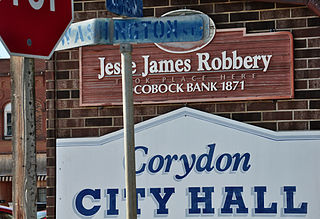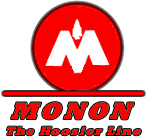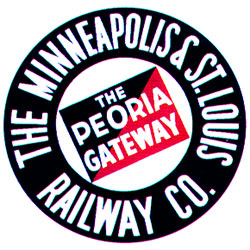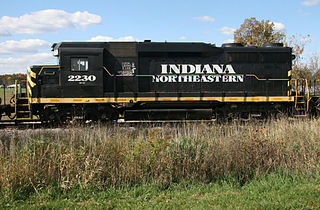
The Denver and Rio Grande Western Railroad, often shortened to Rio Grande, D&RG or D&RGW, formerly the Denver & Rio Grande Railroad, was an American Class I railroad company. The railroad started as a 3 ft narrow-gauge line running south from Denver, Colorado, in 1870. It served mainly as a transcontinental bridge line between Denver and Salt Lake City, Utah. The Rio Grande was also a major origin of coal and mineral traffic.

Clarinda is a city in and the county seat of Page County, Iowa. It is located in Nodaway Township. The population was 5,369 at the time of the 2020 census.

Corydon is a city in Wayne County, Iowa, United States. The population was 1,526 in the 2020 census, a decline from 1,591 in 2000. It is the county seat of Wayne County.

The Kettle Valley Railway was a subsidiary of the Canadian Pacific Railway (CPR) that operated across southern British Columbia, west of Midway running to Rock Creek, then north to Myra Canyon, down to Penticton over to Princeton, Coalmont, Brookmere, Coquihalla and finally Hope where it connected to the main CPR line.

The Chicago, Burlington and Quincy Railroad was a railroad that operated in the Midwestern United States. Commonly referred to as the Burlington Route, the Burlington, or as the Q, it operated extensive trackage in the states of Colorado, Illinois, Iowa, Missouri, Nebraska, Wisconsin, Wyoming, and also in Texas through subsidiaries Colorado and Southern Railway, Fort Worth and Denver Railway, and Burlington-Rock Island Railroad. Its primary connections included Chicago, Minneapolis–Saint Paul, St. Louis, Kansas City, and Denver. Because of this extensive trackage in the midwest and mountain states, the railroad used the advertising slogans "Everywhere West", "Way of the Zephyrs", and "The Way West".

The Monon Railroad, also known as the Chicago, Indianapolis, and Louisville Railway from 1897 to 1971, was an American railroad that operated almost entirely within the state of Indiana. The Monon was merged into the Louisville and Nashville Railroad in 1971, and much of the former Monon right of way is owned today by CSX Transportation. In 1970, it operated 540 miles (870 km) of road on 792 miles (1,275 km) of track; that year it reported 1320 million ton-miles of revenue freight and zero passenger-miles.

The Norfolk and Western Railway, commonly called the N&W, was a US class I railroad, formed by more than 200 railroad mergers between 1838 and 1982. It was headquartered in Roanoke, Virginia, for most of its existence. Its motto was "Precision Transportation"; it had a variety of nicknames, including "King Coal" and "British Railway of America". In 1986, N&W merged with Southern Railway to form today's Norfolk Southern Railway.

The Washington and Old Dominion Railroad was an intrastate short-line railroad located in Northern Virginia, United States. The railroad was a successor to the bankrupt Washington and Old Dominion Railway and to several earlier railroads, the first of which began operating in 1859. The railroad closed in 1968.

The Minneapolis and St. Louis Railway (M&StL) was an American Class I railroad that built and operated lines radiating south and west from Minneapolis, Minnesota for 90 years from 1870 to 1960. The railway never reached St. Louis but its North Star Limited passenger train ran to that city via the Wabash Railroad.

The Burlington and Missouri River Railroad (B&MR) or sometimes (B&M) was an American railroad company incorporated in Iowa in 1852, with headquarters in Omaha, Nebraska. It was developed to build a railroad across the state of Iowa and began operations in 1856. It was acquired by the Chicago, Burlington and Quincy Railroad in 1872, and kept serving as its subsidiary.

The Toledo, Peoria and Western Railway is a short line railroad that operates 247 miles (398 km) of track from Mapleton, Illinois, through Peoria across Illinois to Logansport, Indiana. TP&W has trackage rights between Galesburg, Illinois, and Peoria, between Logansport and Kokomo, Indiana, and between Reynolds, Indiana, and Lafayette, Indiana. TPW has connections with UP, BNSF, NS, CSXT, CN, CP, BL, CERA, CIM, KBSR and T&P. The railroad is now owned by Genesee & Wyoming Inc. The railroad's traffic comes largely from agricultural products, including both raw and processed grain products, as well as chemicals and completed tractors. The TPW hauled around 26,000 carloads in 2008.

The Becker Farm Railroad was located on the Becker dairy farm in Roseland, New Jersey, US. This 2-inch scale, 9+7⁄16 in gauge miniature railway, which featured a live steam locomotive, small-scale diesel locomotives, and small-scale passenger cars, was the brainchild of Eugene Becker. The railroad dated back to 1938, with the first revenue trips taking place ten years later.

The Northern Transcon, a route operated by the BNSF Railway, traverses the most northerly route of any railroad in the western United States. This route was originally part of the Chicago, Burlington and Quincy Railroad, Northern Pacific Railway, Great Northern Railway and Spokane, Portland and Seattle Railway systems, merged into the Burlington Northern Railroad system in 1970.

The Indiana Northeastern Railroad is a Class III short line freight railroad operating on nearly 130 miles (210 km) in southern lower Michigan, northeast Indiana and northwest Ohio. The Indiana Northeastern Railroad Company began operations in December 1992 and is an independent privately owned company. As of 2017 the railroad hauled more than 7,000 carloads per year. Commodities moved by the railroad include corn, soybeans, wheat and flour. It also handles plastics, fiberboard, aluminum, copper, coal, perlite, stone, lumber, glass, rendering products, as well as agricultural fertilizers and chemicals.

The Iowa Northern Railway is a Class III shortline railroad operating in the U.S. state of Iowa.

The Wabash Railroad was a Class I railroad that operated in the mid-central United States. It served a large area, including track in the states of Ohio, Indiana, Illinois, Iowa, Michigan, and Missouri and the province of Ontario. Its primary connections included Chicago, Illinois; Kansas City, Missouri; Detroit, Michigan; Buffalo, New York; St. Louis, Missouri; and Toledo, Ohio.
The Iowa and St. Louis Railway (I&SL) was a subsidiary United States railroad operating in south-east Iowa and north-east Missouri from 1902 to 1947. For most of its existence it was part of the Chicago, Burlington and Quincy Railroad (CBQ), familiarly known as the Burlington System.

Keokuk Union Depot is a historic train station on the west bank of the Mississippi River near downtown Keokuk, Iowa, United States. It was built from 1890 to 1891, and it was listed on the National Register of Historic Places in 2013.

Wabash Combination Depot-Shenandoah, also known as the Shenandoah Wabash Depot, is an historic building located in Shenandoah, Iowa, United States. The depot was built in 1903, and replaced a smaller and older structure. It was designed by and served the Wabash Railroad as a combination passenger and freight station. The Queen Anne and Stick-Eastlake style station was a standard design used by the railroad. The single-story, frame structure features a gabled roof and wide, overhanging eaves. It was an island station that sat in the midst of the tracks. The rear track was used for loading and unloading freight, while the main line rails were along the front. The depot was acquired by the Wabash Trace Nature Trail from the Iowa Southern Railway. The Wabash Trace relocated it to Sportsman's Park in Shenandoah, along the Burlington Northern tracks. The depot was listed on the National Register of Historic Places in 1990.

The Burlington and Northwestern Railway (B&NW) was a 3 ft narrow gauge railroad system in Iowa that operated during the late nineteenth and early twentieth centuries. It connected Burlington, Iowa with branches to Washington and Oskaloosa, Iowa. Incorporated in 1875 as the Burlington and Northwestern Narrow Gauge Railway Company, it began carrying traffic in 1876, when it also dropped 'narrow gauge' from its corporate name. The line reached Washington in 1880, operating over 52.5 miles (84.5 km) of track. In 1881, the Burlington and Western Railway Company, a subsidiary of the Chicago, Burlington and Quincy Railroad (CB&Q) was formed to connect the line to Oskaloosa, completed in 1883. For two decades, both lines were operated as a single system, until on June 20, 1902, the system was widened to standard gauge and the B&NW was adsorbed by the B&W. Later that year, the system was leased to the CB&Q, and in 1903, the entire system was deeded to the CB&Q.

















